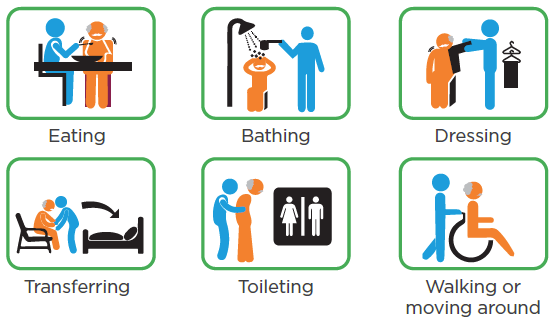Long Term Care: What is it?
The retirement years: a time that should be enjoyed. After all, you have worked hard your entire life – you deserve the world (and perhaps, more) for a job well done. That is, of course, until diseases, mental conditions, disabilities, and other disorders brought upon by old age decide to crash the party.
However, seniors can still make the most out of their twilight years with long term care (LTC). In fact, more seniors definitely need this kind of service – according to the U.S. Department of Health & Human Services, approximately 70% of individuals at the age of 65 and above are expected to have some form of long term care service to help them in their everyday tasks and responsibilities. Find out more about these services below:
Activities of Daily Living (ADLs)
Basically, long term care deals with assisting individuals with daily and basic tasks. These tasks, for categorization purposes, are defined as “activities of daily living” or ADLs. There are 6 ADLs:
Toileting – deals with assisting an individual with his or her business in the toilet and other personal hygiene tasks.
Bathing – support and assistance when it comes to washing or cleaning a person’s body.
Dressing – assists an individual in dressing up properly, and if applicable, fastening of braces, medical equipment, and artificial limbs.
Transferring – assists a person’s mobility (with or without wheelchairs and such).
Eating – supports an individual in the act of eating.
Continence – deals with the assistance and monitoring of a person’s bowel and bladder control.
A common misconception that long term care deals with is that it is a treatment for a disease, disorder, or mental condition related to aging. Although most of the ADLs are in fact due to aging, long term care shouldn’t be defined as a way to treat a condition – it is a way for a person (commonly for seniors) to function properly in their daily lives.
Instrumental Activities of Daily Living (IADLs)
Aside from ADLs, long term care also provides support for more complex tasks. These tasks are defined as “instrumental activities of daily living” or IADLs. Common IADLs are:
Handling and Managing Medication – needed in order for an individual to take the proper and correct dosage of required medication.
Meal Preparation – may involve meal planning for a certain duration or period, and to keep track if the food that an individual will eat is allowed or not.
Grocery Shopping – in relation to a person’s health or medication and meal preparation, assistance to shop for the required food and groceries is also part of long term care.
Household Chores and Home Safety – handles chores that an individual needs to be done at home, and if applicable, installation and maintenance of safety fixtures and medical trackers and monitors.
Phone Call Management – helps the individual answer or reach out to contacts on his or her phone.
Feeding and Care for Pets – assists an individual on bathing, feeding, and caring for pets.
Long Term Caregivers
In terms of assistance mentioned above, either an individual’s family or licensed caregiver professionals can assist. Basically, care can be provided either in a person’s home (in-home care) or in nursing homes and care facilities.
For family caregivers, more often than not, friends and loved ones offer unpaid services to assist the individual in need of long term care. Licensed or professional help, which can be offered in both for home care and at nursing homes and facilities, have access to direct supervision and medical equipment that may address certain needs of a long term care individual.

Is Long Term Care Important?
Stressing the U.S. Department of Health & Human Services study mentioned above, the need of having long term care support is of the same importance as planning early for the services. In fact, planning as early as today can save an individual from the struggles that may come from old age (whether these be financial or health struggles).
As such, people are suggested not to solely rely on their nest egg – it may be depleted quickly, with the costs involved to pay for long term care services. Although LTC costs may vary by state (and in-home and nursing home care), average expenses may range from $45,000 – $88,000 annually, a high figure that most may have trouble paying. This is disturbing since the average savings of a typical individual at the age of 50 will only amount to $40,000.
An alternative to paying for needed LTC services is by applying for a long term care insurance (LTCI) policy. As compared to out-of-pocket spending, an LTCI allows potential policy holders the peace of mind that proper care and attention will be given to them, in case something dire happens in the future. In a sense, the confidence gained with the thought that one has coverage trumps over the fear of facing the unknown in the future – which brings us back to the idea and importance of enjoying the retirement years.
You can plan as early as today for your retirement years with insurance for long term care. Start this by requesting for a long term care quote here.

[…] you are facing retirement, you are probably facing this question, “what is long term care?” Long term care is an issue that everyone will likely face. In order to deal with it properly, […]
[…] need for long term care is on the rise and so does the cost of different services. Presently, it is estimated that 7 out of 10 Individuals […]
[…] Long Term Care: What is it? […]
[…] Long Term Care: What is it? […]